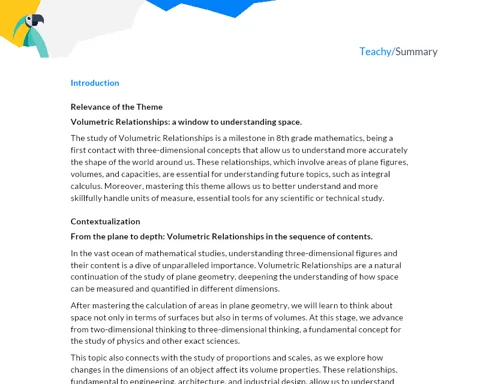Exponentiation: Introduction | Socioemotional Summary
Objectives
1. Understand the fundamental concepts of exponentiation, including base and exponent.
2. Be able to calculate powers of integers and natural numbers, such as 4²=16.
3. Recognize the elements of a power and apply this knowledge in problems.
Contextualization
Did you know that exponentiation is a crucial tool in the world of science and technology? From calculating energy in chemical reactions to understanding population growth, exponents help us solve complex problems more quickly and efficiently. Let's discover how mastering this skill can open incredible doors both in your learning and in your everyday life! 🚀📘
Important Topics
Concept of Exponentiation
Exponentiation is a mathematical operation that uses two main elements: the base and the exponent. This operation is essential for simplifying repeated multiplications and is widely used in various fields, such as science, engineering, and economics. Understanding exponentiation not only enhances your mathematical skills but also your ability to solve complex problems efficiently.
-
Base: The number that will be multiplied by itself. In the expression 4², 4 is the base.
-
Exponent: Indicates how many times the base will be multiplied. In the expression 4², the 2 is the exponent.
-
Notation: Exponentiation is represented as b^e, where 'b' is the base and 'e' is the exponent. For example, 5² means 5 * 5.
Properties of Exponentiation
The properties of exponentiation are powerful tools that help simplify calculations and solve problems more quickly. Knowing these properties can ease the work with complex expressions and provide a deeper understanding of mathematics.
-
Multiplication of powers with the same base: a^m * a^n = a^(m+n). Example: 2³ * 2² = 2^(3+2) = 2⁵ = 32.
-
Division of powers with the same base: a^m / a^n = a^(m-n). Example: 5⁴ / 5² = 5^(4-2) = 5² = 25.
-
Power of a power: (a^m)^n = a^(mn). Example: (3²)³ = 3^(23) = 3⁶.
Practical Applications of Exponentiation
Exponentiation is a crucial tool in various practical applications, from calculating areas and volumes to modeling natural and technological phenomena. Understanding its practical applications not only reinforces your mathematical knowledge but also expands your ability to solve everyday problems.
-
Calculation of areas and volumes: Exponents are used to calculate the area of squares and the volume of cubes.
-
Technological progress: Exponentiation helps describe exponential growth in fields such as computer science and biology.
-
Financial industry: Compound interest in investments is calculated using exponentiation to predict the growth of money over time.
Key Terms
-
Exponentiation: A mathematical operation that raises a number (base) to a power (exponent).
-
Base: The number to be multiplied by itself in the exponentiation operation.
-
Exponent: A number indicating how many times the base will be multiplied by itself.
-
Exponential Notation: A way to represent exponentiation using base and exponent, written as b^e.
-
Properties of Exponentiation: Mathematical rules that facilitate working with powers, such as multiplication and division of powers with the same base.
To Reflect
-
How can understanding the properties of exponentiation improve your ability to solve complex problems in school and life?
-
Think of a moment when you felt challenged by a math problem. How did you deal with your emotions during that challenge, and how did it affect your ability to find a solution?
-
In what way can the practice of mindfulness help you maintain calm and focus when facing academic or personal challenges?
Important Conclusions
-
Exponentiation is a fundamental mathematical operation that involves repeated multiplication of a number, using a base and an exponent.
-
Understanding and calculating powers of integers and natural numbers is essential for solving problems in various fields, such as sciences, engineering, and finance.
-
The properties of exponentiation, such as the multiplication and division of powers with the same base, facilitate the simplification of complex calculations.
-
Developing socio-emotional skills, such as self-control and resilience, during mathematical learning can help face challenges more efficiently.
Impact on Society
Exponentiation is present in various aspects of our daily lives and has a significant impact on different areas of society. For example, in the field of technology, the exponential growth of computer processing capabilities is described using exponentiation. This enables us to create increasingly advanced devices that revolutionize the way we live and work. In biology, population growth of species is often modeled using exponentials, which helps predict trends and make informed decisions about conservation and sustainability.
Moreover, understanding exponentiation can help students develop a growth mindset. By facing complex problems and discovering that they can solve them, students gain confidence and develop a positive attitude towards their academic abilities. This confidence can extend to other areas of life, promoting a more proactive and resilient approach to daily challenges. 🌟💪
Dealing with Emotions
To help manage emotions while studying exponentiation, we will use the RULER method. At home, take a quiet moment to carry out this exercise: Recognize: Observe the emotions you feel before, during, and after studying exponentiation. Write down those emotions. Understand: Reflect on what caused those emotions. Was it the difficulty of the topic? The pressure of time? Label: Name each emotion you felt. For example, 'frustration' or 'contentment'. Express: Share these emotions with someone you trust or write about them in a journal. Regulate: Think of strategies to cope with these emotions positively. It can be a break, a deep breath, or even seeking additional help.
This exercise will help you know yourself better and create more effective coping mechanisms. 📓🧠
Study Tips
-
Create mind maps: Use diagrams and charts to visually represent the relationship between base, exponent, and powers. This helps solidify the content more clearly. 🗺️📊
-
Practice regularly: Do exponentiation exercises every day to strengthen your understanding and gain more confidence in problem-solving. 📅✏️
-
Apply exponentiation in everyday life: Look for everyday situations where you can apply the concept of power, such as in interest calculations or in the exponential growth of something you monitor. 💡🥼



